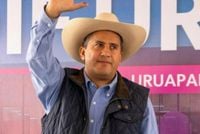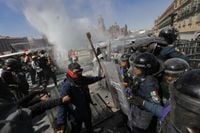The heart of Mexico has been shaken by a surge of violence that is testing the very foundations of its democracy. In the span of just twelve months, ten sitting mayors have been murdered across the country, with the most recent and shocking case unfolding in Uruapan, Michoacán. The assassination of Mayor Carlos Manzo Rodríguez on November 1, 2025—during the vibrant and sacred Día de Muertos celebrations—has become a grim symbol of a crisis that is spiraling out of control.
As families gathered in Uruapan’s plaza, marigolds in hand and candles flickering, gunfire shattered the night. Mayor Manzo, who had been under both federal and municipal protection since December 2024, was gunned down in public view. The killing was not just another statistic in a country that has grown weary of grim headlines; it was a searing reminder that even the most protected local officials remain vulnerable to the reach of organized crime.
Uruapan, a city of 360,000, sits at the crossroads of cartel rivalries. The Jalisco New Generation Cartel, Los Viagras, and the remnants of Los Caballeros Templarios all vie for control, their battles waged over lucrative avocado profits and trafficking routes. According to EFE, the fact that armed men could breach layers of security and strike during a public event has turned Manzo’s murder into a national symbol of impotence. The message is chilling: nowhere, not even in the heart of a festival, is truly safe.
Official tallies reported by EFE reveal that mayors have been killed in states from Oaxaca to San Luis Potosí to Guerrero. Each death is more than a number—it’s a map of municipal fragility, where city halls double as frontlines and public service can come with a death sentence. In Michoacán alone, there have been 25 attacks against political figures in 2025, with 88% targeting municipal officials.
Why are local leaders so exposed? Mexico’s constitution promises a federal system, but in practice, power is heavily centralized. As political scientist Javier Oliva of UNAM told EFE, “The municipal tier is the weakest link in the country’s governing structure. Mexico’s system looks federal, but it behaves like a centralist one.” Local governments are expected to manage everything from sanitation to security, yet they often operate on shoestring budgets and rely on slow, unpredictable transfers from higher levels of government. Municipal police, frequently the only visible arm of the state in small towns, are poorly trained and poorly paid—easy prey for intimidation or infiltration.
Oliva explained, “That explains not just the security problem but urban services, health, everything. When the base of the pyramid cracks, the whole system shakes.” And the cracks are indeed widening. Cartels don’t need to control Mexico City to control Mexico—they need mayors who can be pressured, police chiefs who can be bought, and city councils willing to look the other way. Sometimes, all it takes is a phone call or a visit: sign this permit, ignore that convoy, grant this contract. Refusal is often answered not with negotiation, but with gunfire.
The NGO Data Cívica has labeled this pattern “Votar entre Balas” (Voting Between Bullets). Its analysis, cited by EFE, found that nearly 80% of victims of political-criminal violence in Mexico are local figures. City halls control contracts, police beats, and permits—the levers of daily life. Through those levers flow the lifeblood of criminal economies: extortion, contraband, and protection rackets that operate in plain sight.
Michoacán’s tragedy is a warning for the rest of the country. “It’s a declaration of impunity and defiance,” Oliva told EFE, noting that similar patterns haunt Oaxaca, Guerrero, Tamaulipas, Sonora, Sinaloa, and Guanajuato. Each attack sends a message: the state cannot protect its own. Each funeral widens the space where the law should be. And every new mayor sworn in does so knowing that holding office now carries a death sentence waiting to be enforced.
President Claudia Sheinbaum responded by unveiling Plan Michoacán in November 2025, promising to reinforce security forces and expand social programs. But as Oliva pointed out to EFE, the plan stops short of addressing the core problem: the vulnerability of municipal governments themselves. “Protection means more than a bodyguard,” he said. “It’s a structure that allows mayors to do their jobs without living in fear.”
Real protection, experts argue, must start with funding so that towns can hire competent police instead of desperate ones. It requires coordination, so intelligence flows between city, state, and federal forces. It demands investigation, so the murders of local officials are treated not as isolated crimes but as a pattern of political terror. Emergency protocols, reliable threat assessments, and legal channels for reporting extortion without risking retaliation are essential. Transparency and public briefings can inform citizens when their leaders are in danger, and early warnings can allow events to be canceled without stigma.
But the gap between promise and practice remains fatal. In Uruapan, a mayor with two layers of security died in front of his constituents. The murder didn’t just end a life; it exposed a broken equation in which federal muscle can’t reach municipal ground fast enough. Mexico’s democracy will not fall all at once. It will erode municipality by municipality, one silenced mayor, one captured police station, one plaza ruled by fear.
Anger over Manzo’s killing has spilled into the streets. On November 16, 2025, clashes erupted in Mexico City during a march against violence and corruption organized under the "Generation Z" banner. According to The Associated Press, about 120 people were injured in the capital, including at least 100 police officers—40 of whom required hospital treatment. Authorities reported 20 arrests and 20 civilian injuries in Mexico City, while unrest also spread to Guadalajara, resulting in 13 injuries and 47 detentions, as reported by The Guardian.
The protests, fueled by outrage over Manzo’s assassination, drew support from both younger activists and older opposition supporters, highlighting the breadth of national frustration. Witnesses described a chaotic scene in the Zócalo, where protesters dismantled fencing around the National Palace and riot police responded with tear gas. President Sheinbaum condemned the violence and suggested that the movement had been infiltrated by right-wing parties and amplified by social media bots, according to Reuters.
Organizers, circulating a manifesto under the name “Generation Z Mexico,” described themselves as nonpartisan and motivated by frustration with corruption and violence. Protests occurred nationwide, from Tijuana to Oaxaca, signaling that security and accountability have become central issues in the national debate.
As families in Uruapan and across Mexico gather to light candles and remember their lost leaders, the country faces a stark choice. Mourning cannot become routine. As Oliva told EFE, “Ten mayors in twelve months is not politics, it’s a failure of the state.” The plazas may fill again, and life may resume, but democracy cannot survive if its front lines keep falling.


